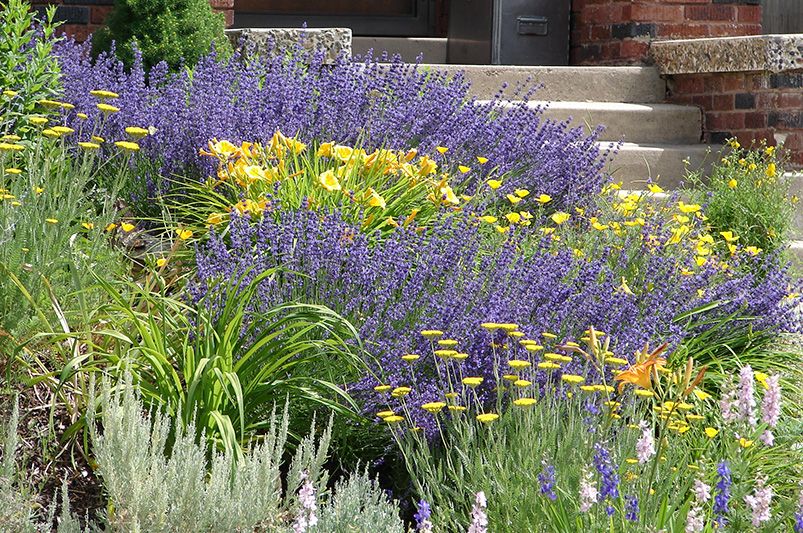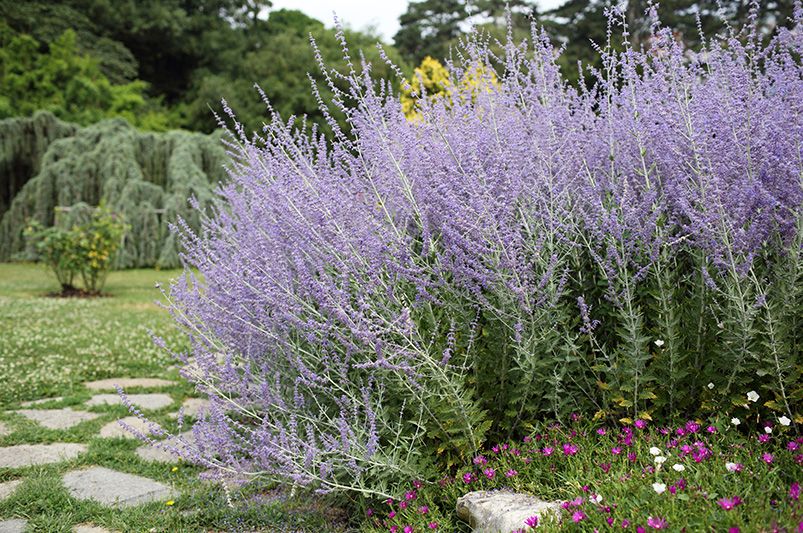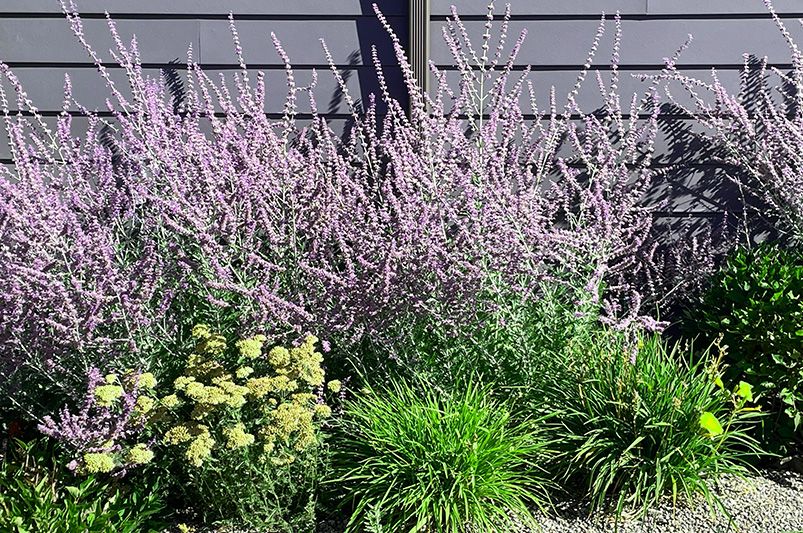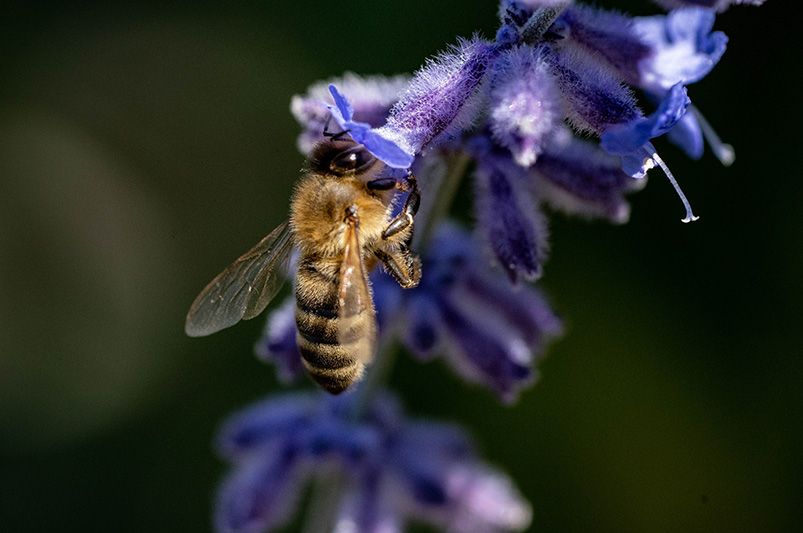
Russian Sage Landscaping Ideas: How to Use Russian Sage in Your Garden Design
Published: 05/03/2024 | Updated: 10/03/2024
If you’re looking for a non-traditional plant that will add a fresh element to your garden, Russian sage is the way to go. This beautiful perennial is a great choice for people who want something different and eye-catching in their yard or on their balcony. It’s also easy to grow with minimal care, making it a great addition to any garden no matter how much time you have available for gardening. In this article, we will be speaking about how to improve your garden with Russian sage deer-resistant plants.


What is Russian Sage and Why is It a Popular Landscaping Plant?
Russian Sage is a perennial shrub that thrives in most climates. It is drought-tolerant, so it's a great choice for areas with dry soil. The plant has beautiful purple-blue flowers that bloom from July to September and make it an excellent choice for late spring and for adding color to your garden design. Russian Sage can grow from four to six feet tall and wide depending on the variety you choose. The flowers are attractive to butterflies and hummingbirds, making this plant even more desirable!

Benefits of Using Russian Sage in Your Garden Design
Russian sage is an easy-to-grow perennial that's ideal for many different types of gardens. It can be used as a ground cover or in mixed borders, but it also makes a great addition to rock gardens and even containers. Russian sage has grayish leaves and silver-white blooms that bloom from mid-summer through fall. it also looks beautiful when it starts to fade out at the end of its growing season. Here are some of the advantages of using the Russian sage plant:
1. Striking Architectural Presence: Russian sage boasts a captivating architectural form, featuring tall, slender stems that gracefully arch towards the sky. Its airy, feathery foliage adds a touch of texture and movement to the garden, creating a visually dynamic display.
2. Long-lasting Blooms: Russian sage is a true showstopper during its blooming season, typically from midsummer to late fall. Its delicate spikes of lavender-blue flowers exude a captivating fragrance that fills the air with a delightful aroma.
3. Drought Tolerance: Russian sage is a low-maintenance plant that thrives in dry conditions, making it an ideal choice for water-wise landscaping. It can tolerate periods of drought without succumbing to wilting or browning.
4. Pollinator Magnet: Russian sage's vibrant blooms are irresistible to pollinators, attracting a variety of bees, butterflies, and hummingbirds. This helps to enhance the biodiversity of your garden and promote pollination of other plants.
5. Versatility in Design: Russian sage seamlessly integrates into a wide range of garden styles, from cottage gardens to modern landscapes. It can be used as a border plant, a backdrop for taller shrubs, or a focal point in container plantings.
6. Deer and Rabbit Resistance: Russian sage is not a favorite among deer and rabbits, making it a reliable choice for gardens in areas where these creatures are prevalent. Its strong fragrance and tough foliage deter unwanted nibblers.
7. Easy Care and Maintenance: Russian sage is a remarkably low-maintenance plant, requiring minimal attention to thrive. It requires infrequent watering and only occasional pruning to maintain its shape and vigor.
8. Long-lasting Cut Flowers: Russian sage's delicate blooms can be enjoyed not just in the garden but also within your home. The flowers make excellent cut flowers that retain their beauty for a surprisingly long time.
9. Adaptability to Various Soil Types: Russian sage is relatively unfussy about soil conditions, tolerating a range of soil types, including sandy, clayish, and loamy soils. It prefers well-drained soil but can also withstand occasional periods of wetness.
10. Winter Interest: Russian sage's woody stems and persistent flower spikes provide visual interest throughout the winter months, adding a touch of structure and texture to the dormant garden.

How to Choose the Right Plant Russian Sage for Your Garden
Selecting the perfect Russian sage variety for your garden depends on several factors, including your desired growth habit, flower color, and landscape style. Here's a guide to help you choose the right Russian sage for your garden:
Growth Habit
Russian Sage is divided into 3 main varieties according to their growth habit. When choosing the right variety for your needs, consider the available space in your garden and the desired visual impact when choosing a Russian sage variety.
-
Tall Varieties: These towering cultivars, reaching up to 5 feet in height, are ideal for creating backdrops, screens, or dramatic focal points. Popular tall varieties include 'Russian Sage' and 'Blue Spire'.
-
Medium Varieties: Standing around 3-4 feet tall, these versatile options provide a balance of height and spread, making them suitable for borders, mixed plantings, or container specimens. Examples include 'Little Blue' and 'Valerie Finnis'.
-
Dwarf Varieties: Compact and well-behaved, dwarf Russian sage varieties reach around 2-3 feet in height, perfect for edging pathways, rock gardens, or front-of-the-border accents. Consider 'Little Blue Dwarf' and 'Zahara'.
Flower Color
You can also consider the color varieties of this beautiful plant when choosing one that suits your landscape. Russian sage typically blooms in shades of lavender, blue, or purple, but some varieties offer subtle variations.
-
Pure Lavender: The classic Russian sage color, and pure lavender flowers exude a delicate charm that complements a wide range of garden palettes.
-
Deep Purple: For a more dramatic statement, consider varieties with deep purple blooms that create a striking contrast against contrasting foliage.
-
Blue Nuances: Varieties with blue-tinged flowers add a touch of coolness and sophistication to the garden, blending seamlessly with other blue or purple hues.

Russian Sage Landscaping Ideas for Different Garden Styles
Russian sage is also perfect for cottage gardens because its bushy form makes it an ideal addition to any landscaping plan. It adds height as well as color to any garden setting, so you can use Russian sage plants anywhere they're needed. Finally, if you're looking for ways to add some Mediterranean flair to your outdoor space without spending too much money on exotic plants, then consider using Russian sage in combination with other drought-tolerant perennials such as lavender or rosemary (also known as Rosmarinus).
Russian is a great plant for all garden styles. It grows well in both formal and informal gardens. It looks especially good when paired with other plants that have similar colors or textures. Here are some ideas for how to incorporate Russian Sage into your landscape and how to choose the right companions:
1. Formal Garden
If you're looking for a perennial that is easy to grow and maintain, Russian sage is an excellent choice. Because it's drought-tolerant and deer-resistant, this plant will thrive even in harsh environments. It grows best in full sun or partial shade with well-drained soil, and it can survive temperatures as low as -10 degrees Celsius. Russian sage also makes an attractive addition to any formal garden design: its tall stems covered with purple flowers look great in lining walkways or bordering beds!
2. Cottage Garden
Cottage gardens are a classic style of garden that originated in England. They're characterized by their simplicity and charm, and they often feature plants that grow well in the region's climate. Russian sage is an excellent choice for cottage gardens because it can thrive in many different climates and soil types, making it an ideal plant for any gardener looking for something low maintenance but still beautiful!
To use Russian sage in your cottage garden:
-
Plant them between other flowers or plants so that they act as a border around your beds. You'll be able to enjoy the color contrast between Russian sage's purple foliage and whatever else you choose to surround it with, and since this type of plant grows quite tall, you may even get some height out of it as well. If you want something more striking than just green leaves against brown dirt though.
-
Mix some red-brown mulch into those beds before adding any other materials like rocks or wood chips. This will give them extra depth when viewed up close versus far away from where most people would stand while admiring their beauty during springtime blooms.
3. Mediterranean Garden
Russian sage is a great plant for the sunny, dry Mediterranean climate of your garden. The plant can be used as a ground cover or in containers and borders. It's also an excellent choice for container gardening because it thrives in hot weather and has few pests.
Russian sage can be planted as a low hedge that will grow up to 3 feet tall by 4 feet wide; this makes it an ideal choice for blocking out unwanted views or keeping animals out of your front garden beds. Because Russian sage grows well in containers or beds, it makes an excellent background plant, just make sure you don't plant too many plants close together so they don't crowd each other out!
Russian Sage Companion Plants
Companion planting is a form of gardening that involves the use of plants that benefit each other. For example, you can plant herbs near your vegetables as they will repel pests and attract beneficial insects. Russian sage (Perovskia atriplicifolia) is a great choice for companion planting because it's drought-tolerant and attracts pollinators like honey bees and butterflies. You can also use this herb to fill gaps in your garden where nothing else will grow well due to a lack of sunlight or poor soil quality.

Russian Sage Planting Tips
Russian sage is resistant to deer and rabbits, but it's susceptible to powdery mildew, leaf spot, and rust. The good news is that Russian sage is also resistant to spider mites which can be a problem with some other types of plants. Here's how you can take care of Russian Sage effectively:
-
Plant in full sun. Russian sage loves the sun, so if you have a sunny spot in your yard, that's where it should go.
-
Plant in well-drained soil. If the soil is too wet or too sandy for the plant to thrive, it will not grow as well and could even die out over time due to root rot or other issues caused by poor drainage.
-
Water regularly during its first year of growth until it becomes established (about six months). Once this happens, only water when temperatures are above freezing if there has been no rain for several days; otherwise just leave them alone!
-
Prune off any dead stems throughout the summer months so they don't become unsightly brown stalks sticking up out of your beautiful landscape bed design--you'll want all eyes on those gorgeous flowers instead.
Get Your Russian Sage Today!
Russian Sage is a great garden plant to use in any style of garden. It's easy to grow and maintain, so you don't have to worry about spending too much time on maintenance or worrying about pests or diseases. If you're looking for something new in your garden design, consider adding some Russian sage plants. Check out ShrubHub’s online store to get your Russian sage today or learn more about our high-quality trees and shrubs.


